Meteo: Part One
By Gorilla Doctors Staff on Wednesday, March 31st, 2010 in Uncategorized.There is a large National Park on the south side of Lake Kivu in the Democratic Republic of Congo (DRC) called Kahuzi Biega. This is a huge protected area that is home to many families of Grauer’s gorillas, several of which are habituated and visited by tourists, now that the area is politically secure again. Grauer’s gorillas and Mountain gorillas are very closely related – they are subspecies of the Eastern Gorilla species (Gorilla beringei).
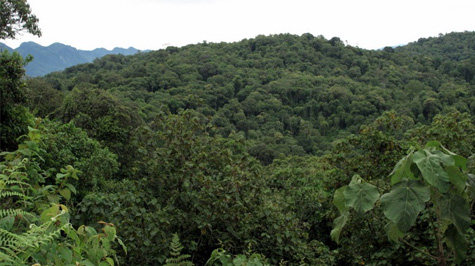 Kahuzi Biega is a beautiful, thick forest with steep ravines and moss covered trees.
Kahuzi Biega is a beautiful, thick forest with steep ravines and moss covered trees.
Gorilla Doctors received a call from Kahuzi Biega rangers that a 3 year old Grauer’s gorilla in one of the habituated groups had a very serious injury to his left wrist. We immediately sent Dr. Jacques to the park to access the wound. This involved a 3 hour boat ride the length of Lake Kivu from Goma to Bukavu, and then a one hour car ride to the park headquarters, and another hour hike through the forest to the group. Here is the first photo we got from Dr. Jacques. Poor Meteo’s left hand was literally falling off.
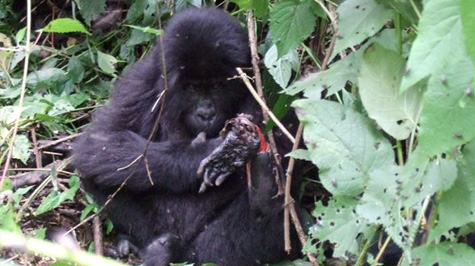 Meteo’s left hand was dead, and the bones of the arm were exposed.
Meteo’s left hand was dead, and the bones of the arm were exposed.
We immediately put together a team to join Dr. Jacques in Kahuzi Biega. Dr. Mike and I, along with MGVP volunteer Dr. Donna Shettko, who is a veterinary surgeon, rushed to Goma to try to get on the late morning boat to Bukavu. Travel between countries is complicated. Dr. Eddy spent hours at Immigration trying to get our Visas sorted out – we were traveling between 2 provinces, so many permissions were required. Unfortunately we missed the last ferry that day while waiting for our Visas, but got on the early ferry the next morning, arriving in Bukavu at 10am. The boat ride down Lake Kivu was beautiful – rolling hills and rugged mountains flanked the length of the lake. But we were focused on the potential task ahead of us. It would be best medically for us to amputate the hand and exposed bones, but we had never done an intervention in this forest with these gorillas. There were many things to consider – field conditions, safety of intervention for gorillas and people, gorilla group composition and temperament, tracker comfort level with the procedure, and PNKB chief park warden’s thoughts and permissions.
We arrived at Park Headquarters at 11am and proceeded directly to the forest after a quick pre-intervention meeting with park officials, rangers and trackers. Trackers found the group easily, but they were resting in a small thicket. It was raining, and the gorillas were not likely to start moving until the rain stopped. Meteo was with his mother Mugeni, hunkered down under a small fallen tree, so we all hunkered down and waited for the rain to stop too. After about an hour the rain tapered off and the gorillas began moving around to find the choicest plants for their mid afternoon snack. Dr. Mike and I prepared anesthetic darts, hoping to get a good shot at both Meteo and Mugeni. We had decided, after a discussion with the senior tracker, that if only one shot could be taken we would start with Mugeni, and hope we could get Meteo once Mugeni was asleep.
The forest underbrush is very dense. At one point there were gorillas all around us, but we could not see them! It was almost 3pm when we finally had an opportunity to dart. Dr. Mike took a shot and got a dart into Mugeni, and she immediately picked up Meteo and was swallowed by the forest. Trackers stayed with her, and as we approached after about 10 minutes it was obvious that she was getting sleepy. Unfortunately Meteo did not stay with his mother. He retreated to the trees, and we learned that all of the gorillas in this particular group were all good tree climbers, preferring to be in the trees much of the day. This made darting Meteo very difficult.
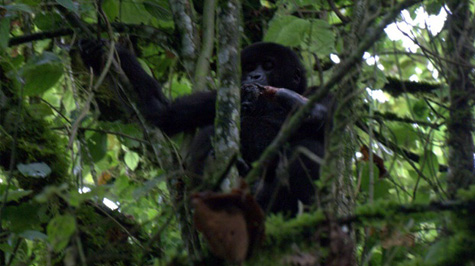 Meteo in the tree, making darting very difficult.
Meteo in the tree, making darting very difficult.
Although we did not have Meteo anesthetized, it was important to monitor Mugeni, and get as many blood samples as possible to learn as much as we could from this anesthetic event. However Chimanuka, the silverback, had other ideas. He is the only silverback for this group of over 30 individuals. He has no young sub-adult males, known as black back gorillas, for assistance in guarding his family, so he took his job very, very seriously. He had been watching us from a distance (at one point he went up a tree and could see us from almost every angle), and did not react immediately when the Mugeni was darted. Once she started showing signs of anesthesia he and the rest of the group became alarmed. They surrounded Mugeni, and Chimanuka placed himself between us and Mugeni. There were some tense moments as he charged our group, but he was doing his job, and we behaved appropriately by stepping back. We had to monitor Mugeni from afar. We could see that she was lying down, breathing normally, but could not approach her to monitor further.
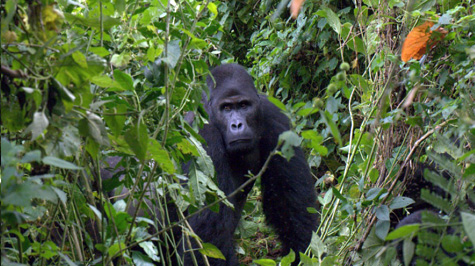 Chimanuka after a charge, telling us to stay away from his family. Mugeni is behind him, sleeping peacefully.
Chimanuka after a charge, telling us to stay away from his family. Mugeni is behind him, sleeping peacefully.
We monitored Mugeni for the next hour. She sat up unsteadily after about 30 minutes, and Meteo sat with her, nursing off and on. After an hour, almost on the nose, she got up and walked away with the rest of the group. Our work was done for the day. We would try again tomorrow.
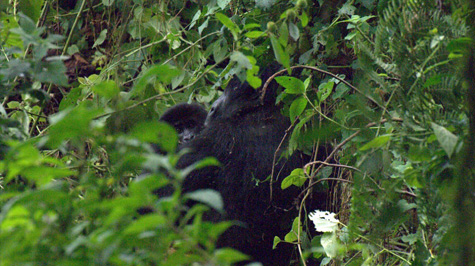 Meteo stayed with Mugeni while she woke up. He peaked at us from the security of his sleeping mother’s arms.
Meteo stayed with Mugeni while she woke up. He peaked at us from the security of his sleeping mother’s arms.
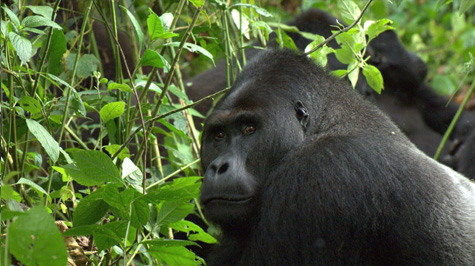 Chimanuka kept a close watch until Mugeni was fully recovered.
Chimanuka kept a close watch until Mugeni was fully recovered.
The next morning we went back to the forest with high hopes. This time we would dart Meteo first, then Mugeni. We really felt it would be best to try to amputate if at all possible. Unfortunately after following the group for almost 8 hours we had no opportunity for a good shot of anesthetic or antibiotic. The gorillas took to the trees and Chimanuka was very watchful. The amazing thing was that Meteo continued to behave almost normally – he ate well, moved well, and in general did not seem too bothered by the dead hand and exposed bone. We were told that he had been the victim of a fight between two silverbacks, but nobody knows for sure how this terrible injury happened. After a long discussion with the head tracker and Chief Park Warden, we decided to head back to Ruhengeri. Trackers would watch daily and report any changes to Dr. Jacques immediately. We would return in a week and try once more to either amputate the exposed bones or at least deliver antibiotics to this poor little gorilla.
Amazed that Meteo was holding his own, and hopeful that he would either heal on his own or that we could help him when we returned next week, we boarded the boat and headed home. It was raining again as we chugged toward Goma, and the storm clouds were heavy over Bukavu.
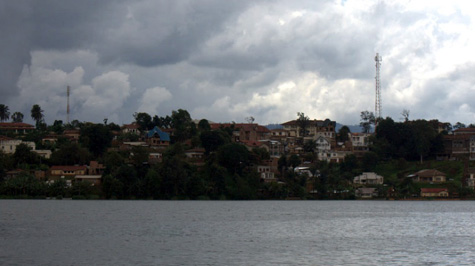 Storm brewing over Bukavu as we headed to Goma on the ferry.
Storm brewing over Bukavu as we headed to Goma on the ferry.
We settled into the 3 hour boat ride, books in hand, and after the first 30 minutes our boat was actually struck by lightning! It was the loudest explosion I believe I’ve ever heard! There was a moment of silence on the boat just after the strike, then lots of animated talking as we all tried to figure out what had happened. The captain turned off the engine for a minute or two, checked his instruments, and then turned the engine back on and we continued on our way. Another first for all of us!
This trip had been a lesson in patience. We Gorilla Doctors never know what to expect, and need to be ready for anything. When we got home we planned our return trip for the following week, and crossed our fingers that little Meteo would continue to be strong.
Help the Gorilla Doctors.


 Donate
Donate